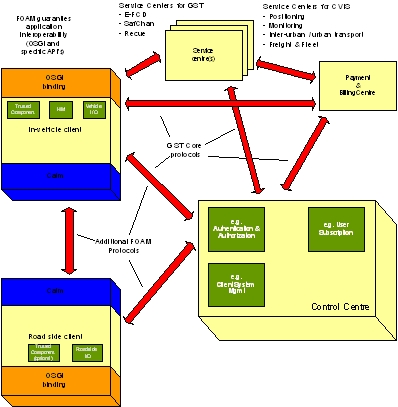FRAMEWORK FOR OPEN APPLICATION MANAGEMENT
The objective of FOAM is to create an open execution environment in which CVIS applications can be developed, delivered, executed and maintained during the lifecycle of in-vehicle and roadside equipment. Drivers and occupants will be able to rely on their integrated in-vehicle system to gain advantages from direct co-operative transport management wherever they drive in Europe. Authorities responsible for the management of the road infrastructure gain advantage from efficient maintenance and easy upgrading of roadside equipment. New transport safety and management control strategies can therefore be easily introduced.
FOAM will define an architecture that connects the in-vehicle systems, roadside infrastructure and back-end infrastructure that is necessary for co-operative transport management. The aim is to produce an architecture and
specification that is implementation-independent, i.e. allows different implementations for various client and back-end server technologies. However, for the reference execution environment, FOAM will create a binding to specific technologies in order to create a fully functional system. The prime candidate for a client binding is Java / OSGi running on top of Unix operating system, most likely NetBSD. A FOAM high-level architecture can be found in the picture below.

The features of FOAM aims are:
- exchange and updating of service application components at any domain in the CVIS architecture
- product / vendor independence by unified or adaptable middleware components
- common design of structural elements (e.g. data exchange formats, protocol specifications, APIís and run-time environment)
- common design of secure communication in distributed systems including billing, authentication of user data and authorization of users
- re-usability of components by generalised access of resources.
The functionality originates from GST and will contain additional features to include roadside infrastructure, context awareness to utilize CALM and ad-hoc networks, intrusion protection, additional CVIS application domains and independence concerningvehicle and road side systems (e.g. vehicle APIís, roadside infrastructure APIís).
Contact
Peter Christ
FOAM Sub-project Leader
ERTICO - ITS Europe
E-mail: p.christ@mail.ertico.com
Sub-Project Partners
|